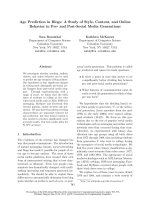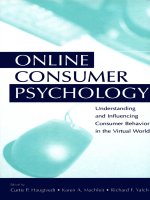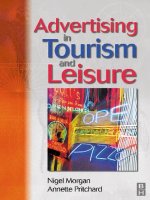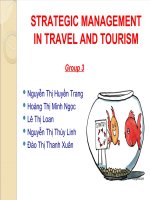Consumer behavior in travel and tourism
Bạn đang xem bản rút gọn của tài liệu. Xem và tải ngay bản đầy đủ của tài liệu tại đây (9.25 MB, 56 trang )
Consumer Behavior
in Travel and Tourism
Consumer Behavior
in Travel and Tourism
Abraham Pizam, PhD
Yoel Mansfeld, PhD
Editors
ROUTLEDGE
Routledge
Taylor & Francis Croup
NEW YORK AND LONDON
First Published by
The Haworth Hospitality Press, an imprint of The Haworth Press, Inc., 10 Alice Street, Binghamton,
NY 13904-1580
Transferred to Digital Printing 2009 by Routledge
270 Madison Ave, New York NY 10016
2 Park Square, Milton Park, Abingdon, Oxon, OX14 4RN
© 1999 by The Haworth Press, Inc. All rights reserved. No part of this work may be reproduced
or utilized in any form or by any means, electronic or mechanical, including photocopying,
microfilm, and recording, or by any information storage and retrieval system, without permission
in writing from the publisher.
Softcover edition published 2000.
Cover design by Marylouise E. Doyle.
The Library of Congress has cataloged the hardcover edition of this book as:
Consumer behavior in travel and tourism / Abraham Pizam, Yoel Mansfeld, editors.
p. cm.
Includes bibliographical references and index.
ISBN 0-7890-0610-3 (alk. paper)
1. Tourism. 2. Travel. 3. Consumer behavior. I. Pizam, Abraham. II. Mansfeld, Y. (Yoel).
G154.7.C66 1999
338.4791—dc21
99-17251
CIP
ISBN 0-7890-0611-1 (pbk.)
Publisher's Note
The publisher has gone to great lengths to ensure the quality of this reprint
but points out that some imperfections in the original may be apparent.
CONTENTS
About the Editors
XV
Contributors
xvii
Introduction
1
PART I: OVERVIEW
5
Chapter 1. Consumer Behavior Related to Tourism
Simon Hudson
7
Learning Objectives
Motivation of Tourists
Typologies of Tourists
Destination Choice
Models of Consumer Behavior in Tourism
The Nonuser
Summary and Conclusions
Concept Definitions
Review Questions
PART II: DESTINATION SELECTION
AND PRODUCT CHOICE
Chapter 2. Estimating What Affects Tourist
Destination Choice
Gordon Ewing
Wolfgang Haider
Learning Objectives
Introduction
Theoretical Background of Discrete Choice Experiments
A Model of Choices of Hypothetical Destinations
on Five Caribbean Islands
A Discrete Choice Experiment on Remote Fly-In
Recreational Angling in Northern Ontario
Summary and Conclusions
Concept Definitions
Review Questions
7
7
11
14
18
27
28
29
30
33
35
35
35
37
39
45
55
56
57
Chapter 3. Understanding the Factors Influencing Ski
Destination Choice: A Means-End Analytic Approach
David B. Klenosky
Charles E. Gengler
Michael S. Mulvey
Learning Objectives
Introduction
Means-End Theory
General Methodology for Assessing Means-End
Relationships
Study Objectives and Methodology
Analysis and Results
Implications for Leisure and Destination Research
Concept Definitions
Review Questions
Optional Project: Measuring Means-End Chains
Chapter 4. The Roles of Image and Perceived Constraints
at Different Stages in the Tourist's Destination
Decision Process
Seoho Urn
John L. Crompton
Learning Objectives
Introduction
The Structure of Destination Choice Sets
Study Hypotheses
Data Collection
Operationalizing Facilitators and Inhibitors
Results
Concluding Comments
Concept Definitions
Review Questions
Chapter 5. Tourists' Decision-Making
and Behavior Processes
A lain Decrop
Learning Objectives
Introduction
59
59
59
60
62
63
65
74
75
76
76
81
81
81
84
87
88
91
93
97
98
99
103
103
103
Major Aspects of Tourists' Decision-Making
and Behavior Processes
The Need for Relativism: Competing Paradigms
in the Social Sciences and in Decision Theory
The Positivist View: The Rational Tourist
The Interpretivist View: The Other Aspect of the Tourist
Summary and Conclusions
Concept Definitions
Review Questions
Chapter 6. Family Decision Making and Tourism
Behaviors and Attitudes
Catherine M. Nichols
David J. Snepenger
104
111
114
121
129
129
130
135
Learning Objectives
Introduction
Data and Method
Findings
Marketing Implications
Recommendations for Future Research
Concept Definitions
Review Questions
135
135
136
138
143
144
145
146
Chapter 7. Consumer Decision Making
and Prepurchase Information Search
John C. Crotts
149
Learning Objectives
Marketing Communications in the Travel and Tourism
Industry
The Nature of Prepurchase Information Search
Types of Information Sought
Amounts and Sources of External Information Search
Determinants of Information Search
Purchase Involvement and Information Search
Strategic Implications
Concept Definitions
Review Questions
149
149
152
154
155
161
161
164
164
166
Chapter 8. Consumer Choice in Context:
The Decoy Effect in Travel and Tourism
Bharath M. Josiam
J. S. Perry Hobson
Learning Objectives
Introduction
Purpose of the Study
Methodology
Findings
Implications
Limitations
Conclusions
Concept Definitions
Review Questions
Chapter 9. Package Tourism and Customer Loyalties
Monica Hanefors
Lena Larsson Mossberg
Learning Objectives
Chapter Aim and Structure
Package Tourism
Travel Experiences and Loyalties
Descriptors of Package Tourism Loyalties
Summary and Conclusions
Concept Definitions
Review Questions
PART III: PERCEPTIONS, EXPECTATIONS,
AND SATISFACTION
Chapter 10. Destination Image and Its Modification
After Travel: An Empirical Study on Turkey
Silvia Sussmann
Arzu Ünel
Learning Objectives
Destination Image
Image and Marketing
An Empirical Study of the Image Change Induced
by Actual Experience of Turkey
169
169
169
172
172
177
180
181
182
182
183
185
185
185
186
187
190
198
200
201
205
207
207
207
213
219
Conclusions
Concept Definitions
Review Questions
Chapter 11. Valuing Changes to Scenic Byways
Timothy J. Tyrrell
Maureen F. Devitt
Learning Objectives
Introduction
Economics of Travel Choice Behavior
Survey Methodology
The Logit Model
Maximum Likelihood Estimates
Willingness to Pay for Roadway Changes
An Applications Workbook
Limitations
Conclusions
Concept Definitions
Review Questions
Chapter 12. Tourism Expectation Formation:
The Case of Camper-Van Tourists in New Zealand
Jurgen Gnoth
Learning Objectives
Introduction
Developing an Understanding of Expectations
The Constructs or Tools
Motives and Motivations
Values
The "Logic" of Values
Attitudes
Expectations
Emotions
Empirical Investigation of Expectations:
Camper-Van Tourists in New Zealand
Concept Definitions
Review Questions
223
223
225
227
227
227
228
231
233
235
235
240
241
242
242
243
245
245
245
246
247
247
250
251
252
253
255
257
264
264
Chapter 13. From the Psychometrics of SERVQUAL
to Sex: Measurements of Tourist Satisfaction
Chris Ryan
267
Learning Objectives
267
Introduction
267
The Development of Service Quality Theory
268
The Development of SERVQUAL
270
Gap Analysis—Measures of Satisfaction
and Service Quality
272
Relationship Between Gap Models and Tourist Experience 278
Summary and Conclusions
281
Concept Definitions
283
Review Questions
283
Chapter 14. Cognitive Distance: A Neglected Issue
in Travel Behavior
David J. Walmsley
John M. Jenkins
Learning Objectives
Introduction
Cognitive Distance
Distance Cognition
A Case Study
Conclusions and Implications
Concept Definitions
Review Questions
PART IV: RESEARCH METHODS
IN TOURIST BEHAVIOR
Chapter 15. Quantitative Tools in Tourism Research:
An Application of Perceptual Maps
Michael Luckett
Jaishankar Ganesh
Peter Gillett
Learning Objectives
Introduction
Marketing Research As a Managerial Tool
Consumer Perceptions and Product Positioning
287
287
287
288
290
292
299
301
301
305
307
307
307
308
309
Approaches to Positioning
Perceptual Maps
Creating a Perceptual Map
Research Design
Interpreting Perceptual Maps
Conclusion
Concept Definitions
Review Questions
Appendix: Athletic Footwear Survey
Chapter 16. Qualitative Research Methods for the Study
of Tourist Behavior
Alain Decrop
311
313
315
316
319
321
322
323
324
335
335
Learning Objectives
Introduction
335
The Need for Qualitative Approaches in Tourism Research 336
Strategies of Qualitative Inquiry
339
Data Collection
345
353
Analyzing and Interpreting Data
Summary and Conclusions
360
Concept Definitions
361
Review Questions
362
PART V: TOURIST BEHAVIOR
Chapter 17. Cruise Consumer Behavior:
A Comparative Study
Ngaire Douglas
Norman Douglas
Learning Objectives
Historical Background
Cruising in the 1990s
Literature and Research Method
Ships of the Study
Passenger Profiles
Passenger Behavior
Arrival and Embarkation
Meals
Passenger Activities
367
369
369
369
370
371
372
375
380
381
382
383
Ports
Itineraries Traveled for This Study
Conclusion
Concept Definitions
Review Questions
Chapter 18. Cross-Cultural Tourist Behavior
Abraham Pizam
Learning Objectives
Tourism and Culture
The Convergence-Divergence Debate
Cross-Cultural or National Character Research
Cross-Cultural Studies in Tourism
Objections to Cross-Cultural/National Research
Objective
Methodology
Results
Conclusions
Limitations of the Studies
Concept Definitions
Review Questions
Chapter 19. Consumer Behavior in the U.S. Pleasure
Travel Marketplace: An Analysis of Senior
and Nonsenior Travelers
Rajshekhar G. Javalgi
Edward G. Thomas
S. R. Rao
Learning Objectives
Introduction
Related Research
Study Objectives
Methodology
Results
Implications and Conclusions
Concept Definitions
Review Questions
388
388
390
391
391
393
393
393
394
395
396
399
400
401
404
406
407
407
408
413
413
413
415
416
416
417
424
427
427
Chapter 20. Patterns of Tourist Expenditure and Types
of Vacation Across the Family Life Cycle
Robert Lawson
Learning Objectives
Introduction
Study Background and Context
Distribution of FLC Observations
The FLC and Vacation Expenditure
Holiday Differences Over the FLC
Conclusions
Concept Definitions
Review Questions
Chapter 21. Developing Travel Lifestyles:
A New Zealand Example
Robert Lawson
Maree Thyne
Tracy Young
Biljana Juric
Learning Objectives
Background and Introduction
Study Development
Conceptualizing Travel Lifestyles
Developing a Lifestyle Measurement Instrument
Data Analysis
Cluster Descriptions
Discussion and Conclusions
Concept Definitions
Review Questions
Chapter 22. Travel-Related Lifestyle Profiles
of Older Women
Douglass K. Hawes
Learning Objectives
Introduction
Related Research
Focus of the Study
Research Methodology
431
431
431
432
434
437
439
445
446
446
449
449
449
451
452
455
458
460
474
476
476
481
481
481
482
484
485
Analysis
Results
Conclusions and Implications
Concept Definitions
Review Questions
486
487
505
507
508
Summary and Conclusions
Abraham Pizam
Yoel Mansfeld
513
Index
515
A B O U T T H E EDITORS
Abraham Pizam, PhD, is Professor of Tourism Management in the Department of Hospitality Management and Director of the Dick Pope Sr.
Institute for Tourism Studies at the University of Central Florida in Orlando. Previously, he served as Director of Graduate Programs in the Department of Hotel, Restaurant, and Travel Administration at the University of
Massachusetts. Widely known in the field of hospitality and tourism management, Dr. Pizam has conducted several international research projects,
and served as a consultant in more than thirty countries. He has held
various academic positions in the United States, United Kingdom, France,
Austria, Australia, New Zealand, Singapore, Israel, and Switzerland. In
addition, Dr. Pizam is the author of more than 100 scientific publications
and four books and is on the editorial boards of ten academic journals in
his field.
Yoel Mansfeld, PhD, is Chair of the Center for Tourism, Pilgrimage, and
Recreation Research and Senior Lecturer in the Department of Geography
at the University of Haifa. He is the author of more than twenty refereed
publications and numerous technical reports, and serves on the editorial
boards of several journals.
XV
Contributors
John L. Crompton is Professor of Recreation, Park, and Tourism Sciences
in the Department of Recreation, Park, and Tourism Sciences, College of
Agriculture and Life Sciences, Texas A&M University, College Station.
John C. Crotts is Associate Professor and Director of the Hospitality and
Tourism Management Program in the School of Business and
Economics, College of Charleston, Charleston, South Carolina.
Alain Decrop is a Research Assistant in the Department of Business
Administration, University of Namur, Belgium.
Maureen F. Devitt is with The Cadmus Group, Waltham, Massachusetts.
Ngaire Douglas is Senior Lecturer and Director of Studies in the School
of Tourism and Hospitality Management, Southern Cross University,
Lismore, NSW, Australia.
Norman Douglas is Director of Research Consultancy, Pacific Profiles,
Australia.
Gordon Ewing is an Associate Professor in the Department of Geography,
McGill University, Montreal, Quebec, Canada.
Jaishankar Ganesh is Assistant Professor of Marketing, Department of
Marketing, College of Business Administration, University of Central
Florida, Orlando.
Charles E. Gengler is Associate Professor in the Department of Marketing,
School of Business at Baruch College, City University of New York,
New York.
Peter Gillett is Professor of Marketing, Department of Marketing,
College of Business Administration, University of Central Florida,
Orlando.
Jurgen Gnoth is a Senior Lecturer in the Department of Marketing,
University of Otago, Dunedin, New Zealand.
Wolfgang Haider is Assistant Professor in the School of Resource
and Environmental Management, Simon Fraser University, British
Columbia, Canada.
xvii
xviii
CONSUMER BEHAVIOR IN TRA VEL AND TOURISM
Monica Hanefors is Senior Lecturer in Tourism and Travel/Social
Anthropology, School of Transportation and Society, Darlarna University College, Borlänge, Sweden.
Douglass K. Hawes is a retired Professor who previously taught
at the University of Wyoming, Laramie, Wyoming.
J. S. Perry Hobson is Senior Lecturer in Marketing, School of Tourism
and Hospitality Management, Southern Cross University, Lismore,
NSW, Australia.
Simon Hudson is Senior Lecturer in the School of Service Management,
University of Brighton, Eastbourne, United Kingdom.
Rajshekhar G. Javalgi is Professor of Services Marketing, James J.
Nance College of Business Administration, Cleveland State University, Cleveland, Ohio.
John M. Jenkins is Senior Lecturer in the Department of Leisure and
Tourism Studies at the University of Newcastle, Callaghan,
Newcastle, NSW, Australia.
Bharath M. Josiam is Associate Professor in the Department of Hospitality
and Tourism, University of Wisconsin-Stout, Menomonie, Wisconsin.
Biljana Juric is Senior Lecturer in the Department of Marketing,
University of Otago, Dunedin, New Zealand.
David B. Klenosky is Assistant Professor in the Department of Health,
Kinesiology, and Leisure Studies, Purdue University, West Lafayette,
Indiana.
Robert Lawson is Professor of Marketing at the University of Otago,
Dunedin, New Zealand.
Michael Luckett is Assistant Professor of Marketing, Department of
Marketing, College of Business Administration, University of Central
Florida, Orlando, Florida.
Lena Larsson Mossberg is Senior Lecturer in Marketing, School of
Economics and Commercial Law, Goteborg University, Goteborg,
Sweden.
Michael S. Mulvey is Assistant Professor in the Department of Marketing,
School of Business, Rutgers University, New Brunswick, New Jersey.
Catherine M. Nichols is with the University of Alaska, Fairbanks.
S. R. Rao is Executive Director of Academic Programs and Associate
Professor of Marketing, James J. Nance College of Business
Administration, Cleveland State University, Cleveland, Ohio.
Contributors
xix
Chris Ryan is Editor in Chief, Tourism Management, and Professor
in the Tourism Program, Center for Management Studies, University
of Waikato, Hamilton, New Zealand.
David J. Snepenger is Associate Professor of Marketing in the College
of Business, Montana State University, Bozeman, Montana.
Silvia Sussmann is Senior Lecturer in Management Computing, School
of Management Studies for the Service Sector, University of Surrey,
Guildford, Surrey, United Kingdom.
Edward G. Thomas is Professor of Marketing in the James J. Nance
College of Business Administration, Cleveland State University,
Cleveland, Ohio.
Maree Thyne is a Research Fellow working on a tourism research
program at Otago University that is funded by the New Zealand
Foundation for Research, Science and Technology, University
of Otago, Dunedin, New Zealand.
Timothy J. Tyrrell is Professor of Tourism Economics, Department
of Environmental and Natural Resource Economics, University of
Rhode Island, Kingston.
Seoho Urn is Associate Professor in the Department of Tourism and
Recreation, Kyonggi University, E-We-Dong, South Korea.
Arzu Ünel has recently completed an MSc in Tourism Marketing at the
University of Surrey, Guildford, Surrey, United Kingdom.
David J. Walmsley is Professor of Geography and Planning, School of
Geography, Planning, Archaeology, and Palaeoanthropology, University of New England, Armidale, NSW, Australia.
Tracy Young is a Research Fellow working on a tourism research
program at Otago University that is funded by the New Zealand
Foundation for Research, Science, and Technology, University of
Otago, Dunedin, New Zealand.
Introduction
Abraham Pizam
Yoel Mansfeld
The question of how people consume travel and tourism products has
become a focal point in tourism research in the past two decades. Efforts to
unveil the determinants that shape travel behavior stemmed not only from
pure academic interest, but from practical business considerations as well.
The evolving marketplace of the travel industry has realized that understanding travel behavior is imperative in today's highly competitive business environment. After all, in such circumstances the ability to compete
effectively is highly correlated with the ability to tailor the travel product
to tourists' needs, expectations, and desires. This mutual interest forms the
raison d'etre for Consumer Behavior in Travel and Tourism.
In recent years, a growing number of published research works have
improved our body of knowledge in this highly important domain. However, these scholarly studies are scattered in numerous journals and have
never been incorporated into a single volume that summarizes all explored
and, as yet, not fully explored issues in tourists' consumer behavior. The
aim of this volume is twofold. First, it represents for the first time an
attempt to explore, define, analyze, and evaluate the state of the art in this
multifaceted phenomenon of consuming tourist and travel products. Second, it packages the various issues and aspects of consumer behavior in
travel and tourism in the form of a textbook, to be used by both students
and practitioners. Thus, each chapter includes learning objectives, main
concept definitions, and review questions.
The book comprises five main sections. In search of improved
approaches to marketing tourist products, Part I consists of a comprehensive discussion of the main factors that affect consumer behavior in travel
and tourism. This discussion unveils, in a critical manner, the relationship
between travel motivation, destination choice, and the consequent travel
behavior. While evaluating these relationships, the chapter stresses the
as-yet undiscovered issue of nonparticipants and their reluctance to travel.
Part II explores in greater detail the manner in which different consumers go through various decision-making processes that lead to consequent
1
2
CONSUMER BEHAVIOR IN TRA VEL AND TOURISM
destination choices and spatial behaviors. Using various case studies such
as a ski destination choice or decisions to visit Disney World in Florida,
the section defines the unique characteristics of the tourist product, followed by an analysis of the major factors and constraints that shape each
stage in the decision-making process. Based on observations illustrating
the "push" and "pull" factors as well as various constraints imposed on
potential travelers, this section also makes some marketing recommendations. It suggests that to succeed in this highly competitive environment,
the tourism industry must improve the level of compatibility between
tourists' expectations and their actual travel experience.
Because tourism is an intangible product, and since there normally is a
time lag between the purchase of this product and its actual consumption,
travelers develop a cognitive image of the product they bought. Part III of
this book demonstrates how this image is created, developed, and changed
as the traveler moves from a decision-making stage to a traveler stage. It is
suggested in this section that the changing image of a given destination
and the evolving travel experiences can have a major effect on travelers'
satisfaction levels. Today, tourism practitioners and destination managers
have at their disposal a variety of research techniques that enable them to
measure the gap between expected and actual travel experience. Thus, one
can evaluate the extent to which the quality of a given tourist product
meets customer expectations and from this find ways to constantly
improve it.
The availability of sophisticated research techniques aimed at understanding destination choice and tourists' spatial behaviors is imperative in
a growing competitive business environment. Part IV discusses some
selected research tools and evaluates the marketing implications of using
qualitative and/or quantitative research techniques.
Finally, Part V, which concludes this book, examines the relationships
between consumers' characteristics and their behavior as tourists. The
section portrays possible environmental, socioeconomic, cultural, and/or
demographic influences on how potential tourists select from among
travel alternatives, choose their preferred destination, and behave while on
site. It shows that consumer behavior in travel and tourism is shaped, after
all, by both individual and environmental factors. We hope that after
reading this book, students, practitioners, and fellow researchers will be
better equipped to detect and analyze the relative roles of these two major
types of behavioral determinants.
Consumer Behavior in Travel and Tourism would not have been possible without the commitment and dedication of our colleagues who contributed their valuable academic and industrial experience in this field. We
Introduction
3
would like to thank all of them—those who wrote their chapters specifically for this book and those who kindly allowed us to republish their
outstanding research findings and theoretical developments. Special
thanks go to Charles Goeldner, editor of the Journal of Travel Research,
who gave us permission to use some articles that were previously published in his journal. We would also like to express our gratitude to the
many colleagues and practitioners who strongly supported our initiative to
edit this volume. The evident lack of such a textbook deterred many of
them from teaching this highly practical topic as a full-fledged course. We
believe that with this book, that opportunity can be realized. We are also
grateful to the Research Authority of the University of Haifa, which financially supported the production of this book. Finally, a word of appreciation for three special women: Olga Sagi, who was responsible for the
English editing, Genoveba Breitstein, who was responsible for typing and
arranging the book according to the publisher's requirements, and Shoshi
Mansfeld, who (re)produced all the graphic work for this book. By extending their professional skills they have contributed immensely to the successful production of this book.









